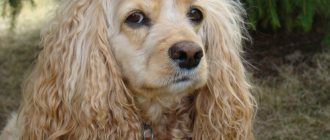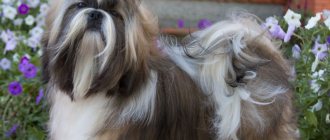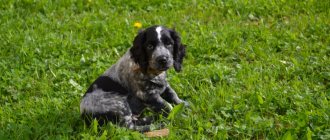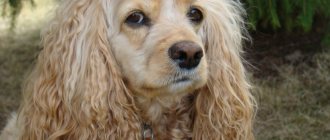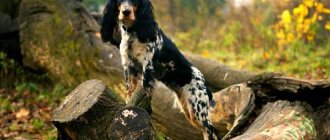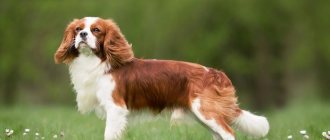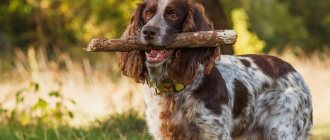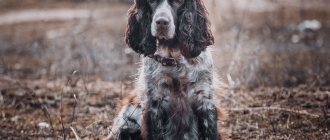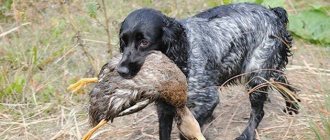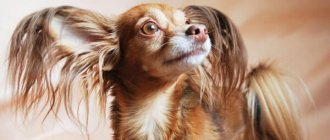In dog reviews, spaniels are almost always singled out as the most popular breeds. The cuteness of these four-legged animals is complemented by their excellent intelligence. We are talking about the well-known American cocker, English spaniel, as well as independent breeds. For each of these types, the masters of our salon will be able to choose the optimal haircut, necessarily taking into account all the wishes expressed by the owner of the animal. For our groomers-stylists, such work is not routine work, but full-fledged creativity. Their experience will allow you to create a new, unique image every time.
Basic requirements for a haircut
Dog breeders often prefer American, Russian, and English spaniels. Each variety has its own haircut characteristics, but in any case there are basic rules and requirements for the hairstyle of a purebred pet:
- on the back, head and muzzle the hair should be short;
- on the paws and along the body there are featherings;
- curliness and waviness - in small quantities.
A hygienic haircut is a must, which can be done at home. To participate in the exhibition, it is better to contact a specialist.
Photo gallery
Haircut standards are shown in the photo:
American black cocker spaniel
English red cocker spaniel
English black cocker spaniel
Types of haircuts and their features
The types of hairstyles depend on the appearance, as well as on the purpose for which the spaniels are groomed. The first time a dog is cut as a puppy is at 2 months of age, as it grows overgrown.
The hairstyle is divided into 2 types: full and partial.
The first must be done with a hairdresser, for which the pet is taken to the salon or a specialist is invited to your home. The second is also called hygienic and is carried out as needed at home.
Expert opinion
Anna Abramenko
An avid dog lover. Experience in veterinary medicine since 2009.
Ask a Question
Breeds also matter. Each type of spaniel has its own type of hairstyle.
For Russian Cocker Spaniel
Of the three varieties, this breed has retained its working status the most. The Russian Spaniel is often used not only as a domestic dog, but also as a hunting dog. Therefore, his appearance in this case should be not only beautiful, but also reasonable.
Expert opinion
Anna Abramenko
An avid dog lover. Experience in veterinary medicine since 2009.
Ask a Question
The main rule in the Russian Cocker's hairstyle is that it looks as natural as possible, and it is not noticeable that the spaniel was cut artificially.
Appearance nuances:
- do not shorten the hair on the underbelly and tail, on the back of the paws;
- do not touch the neck, ears and chest, except for the genitals;
- Use a fine-tooth comb to keep the coat straight;
- It is better not to change the length of the tail; remove protruding hair with scissors;
- trim fluff.
It is recommended to do a haircut 30 days before the exhibition, then the hairdresser’s actions will not be so noticeable and the dog’s score will not be reduced.
For American Spaniel
Unlike its Russian counterpart, this breed has long been used only as a companion and does not participate in hunting. Therefore, its wool became a decorative object of admiration.
Historical reference
It is believed that the concept of “spaniel” comes from Spain; people often call the dogs “Spanish dogs”. In the canine sense, a spaniel is a breed group of gundogs of English origin that search, jump and bark, pick up, and then, on command, serve shot game birds. Traditionally, dogs are divided into land and water dogs, but there are also generalists.
This is interesting! Experts do not deny the Spanish origin of the breed, but the main breeding work to improve spaniels was carried out by English breeders. The Russian Hunting Spaniel has no relation to England, but is a deliberately bred variety, a descendant of the best representatives of the English breed group.
Until the 19th century, breeds were not separated at all. The first distinction concerned the size of the dogs. Animals whose weight was less than 10 kg were called cocker spaniels, and four-legged animals that outgrew this “limit” were called springer spaniels. The surge in the canine world interested experts and the breed line began to develop rapidly. The British widely used Poodles and Cocker Spaniels in breeding work; as a result, more than 10 new breeds were released into the world. Breeders from the USA did not lag behind; they bred the American Cocker and Water Spaniel.
Small height and weight have become particularly valued traits of the breed. The dogs easily passed through dense thickets, swam well and even dived to retrieve wounded animals. Representatives of the breed group also came to Russia (1884), but never won a wide circle of fans. From 1939 to 1945 there was a fierce Second World War, which had a detrimental effect on the development of breeds in all countries affected by the conflict. Since the Soviet Union was one of the key participants in the conflict, active breeding work was out of the question.
In the post-war years, it turned out that even the surviving pedigree dogs did not shine with purity of blood. It was expensive to import four-legged animals from abroad, especially in conditions of foreign exchange shortage. A solution was found in breeding our own breeds. Activities were carried out at the state level and under control from above. Regarding spaniels, the situation was more chaotic. The dogs imported into the territory of the union were bred indiscriminately until the Spaniel Club took control of the breeding work.
Numerous interbreed matings were carried out with one goal - to adapt the “Spanish women” to hunting on Russian territory. The rapid mixing of blood gave a positive result - a new variety of spaniel was bred and official breeding work began on the basis of the created gene pool. Since 1951, the breed standard came into force in Russia, and breeders were given specific tasks - to increase the growth, strength and endurance of dogs.
Controlled, planned and thoughtful breeding has brought great success. It took breeders more than 10 years to popularize and improve the domestic breed. By the mid-1960s, Russian hunting spaniels confidently ousted their “overseas brothers” from the show rings. The surge in popularity came in 1990, when spaniels began to confidently compete with the Setter group. Slowly but surely, Russian hunting spaniels reached the United States, where the first breed club was registered in 2002.
Step-by-step grooming for your pet at home
You can create beautiful hair at home, not just for an exhibition. This is not as difficult as it seems at first, and experienced spaniel owners can easily cope with this task.
The following tools will be needed for the job:
- scissors - simple and thinning;
- hair clipper (preferably specialized for dogs);
- comb with short teeth (slicker brush).
It is optimal if, for the first time, the owner takes a master class from an experienced specialist who will tell you how to properly and beautifully treat your pet.
The first stage is preparatory. Hair should be dry and carefully combed. Cut and remove tangles, bathe, dry and comb the dog again.
At the second stage, cut off all split ends, and then process small parts: ears, muzzle, paws. Grooming a cocker spaniel at home requires care so as not to cause harm. The next step is to treat the pet's body.
Here are a few tricks to consider:
- Be sure to remove the hair that grows inside the ear.
- Areas that require the shortest possible hair are cut with a clipper. This must be done carefully so as not to injure the animal.
- A hygienic haircut necessarily involves removing hair from the anus and genital area.
If the owner does not intend to submit the dog for evaluation, then a sporty hairstyle can be done, when the hair is cut as short as possible. A machine is enough for this.
Expert opinion
Anna Abramenko
An avid dog lover. Experience in veterinary medicine since 2009.
Ask a Question
If you cut your American Spaniel's hair too short and cut off the hair on his back, it will be difficult to get him in full order in the future, since the hair on top will become very bristly.
Content
The Russian Spaniel is unpretentious in its maintenance. You need to determine a place for it in an apartment or house. It should not be in a dark corner, in a draft, near the entrance door, or near radiators. The bathroom and kitchen are also not suitable. A dog should sleep only in the place assigned to it. Don't forget about regular cleaning.
As a bed, you can use a basket with low sides, a wooden box or a textile mat. Consider the size of the animal. The dog should fit there calmly in any position.
In spring and autumn, spaniels begin to shed. If the air in the room is dry, it will be more noticeable.
Some owners tend to believe that keeping a spaniel in an apartment is unacceptable. This weakens its performance, turning the pet into a decorative dog. The Russian spaniel is, first of all, a hunting breed. He has a dense, thick undercoat. It is adapted to any weather conditions. Therefore, keeping him outside is perfect for him. There is somewhere to roam and something to chew, you can throw out all your energy.
Of course, it is better if the booth in the enclosure is insulated. This will avoid diseases during the cold season and protect the dog from rain and wind. It is better to choose a dry place, on a hill, at a distance of 10-15 meters from residential premises. Preferably in the shade of trees.
Do not keep your dog in a closed barn or near other animals: sheep, goats, etc.
Showroom price
Tep grooming or salon haircut is not just about creating a pleasant appearance. The specialist provides a whole range of services to the dog, including: trimming nails, removing tartar, cleaning the anal glands, and caring for the ears.
The cost of grooming depends on many factors and varies between salons. On average, the price varies from 1300 to 3000 rubles. If you order a groomer to come to your home, the procedure will cost more.
Health
The average life expectancy of the Russian Hunting Spaniel ranges from 13–16 years, subject to timely vaccination, quality feeding and care. The wide “base” used during breeding and strict control by the Spaniel Club protected the breed from common hereditary diseases. Russian Spaniels are only prone to:
- Otitis - all dogs with long ears are prone to this disease. Proper care, quality feeding and timely ear cleaning reduce the risk of disease to a minimum.
- Food allergy is an aggressive reaction of the immune system in response to irritants (allergens) entering the body, in the case of the Russian Spaniel - food. Not all dogs are allergic, and if pathology is detected most often, it affects a rather narrow list of products. Symptoms of food allergies: widespread itching, excessive ear lubrication, red eyes, watery eyes, runny nose.
- Obesity is a consequence of improper maintenance, metabolic disorders or age-related degenerative changes.
Photo and video review
In the gallery you can visually familiarize yourself with the most fashionable hairstyles for spaniels of all three varieties. This is both the appearance of the dog and its cleanliness. And at the exhibition they will give you extra points for such beauty.
All owners should groom cockers. It doesn't matter whether the dog participates in competitions or not. At a minimum, hygiene procedures should be carried out regularly. For a fashionable hairstyle, you will have to go to a specialist in a salon or call a groomer to your home.
Mating
- Upon reaching 8-9 months, representatives of this breed enter sexual maturity, but they are ready for mating after the body has fully matured. Males reach puberty at 8-10 months. But this moment is individual for each dog.
- An experienced and active bitch is selected for a young male. A dog's breeding career largely depends on the first time.
- The female is ready for mating on the 11-13th day of estrus, but before the procedure the animals must be vaccinated. Before mating, the pets are prepared and introduced so that they feel confident. After getting to know each other, they bring the animals together and help them mate. To do this, experienced breeders keep the female, the owner can hold the cable.
Do I need to cut my hair?
An English Cocker needs to be groomed regardless of whether he is being shown or not . After all, in addition to the fact that a haircut gives dogs a beautiful and well-groomed appearance, it is also necessary for hygiene purposes.
Plant seeds, various debris and external parasites cling less to the shortened coat; it does not tangle and mat so much, forming tangles that cause discomfort to the spaniel.
Working cockers also need a haircut, since in the forest or in the field the too long hair of an uncut dog will constantly cling to the branches of bushes and collect dirt and various debris..
As for show dogs, only a beautifully and correctly trimmed cocker will be appreciated by experts and will be able to qualify for prizes, not to mention the championship title.
Grooming makes caring for an English Cocker much easier, since short and straight hair is easier to comb than long and constantly tangled hair.
Care after grooming
After grooming, you need to maintain the condition of your pet’s hair so that it does not turn into a matted felt boot before the next haircut. Care is not that difficult, but requires regularity and some persistence on the part of the owner.
Bathing
When walking through mud, long and medium coats should be protected with waterproof overalls. A cocker is given a full bath no more than once every 1-1.5 months; many owners try to combine a “bath day” with nail trimming. Cockers are washed with special shampoos for long hair; it is advisable to select the product according to the color of the hair. After the bath, the furry friend is dried with a towel, dried with a hairdryer and combed, removing tangles if necessary.
Combing
They comb the cocker every other day, if the dog likes the procedure, then you can do it every day. Combing has a beneficial effect on the skin, improving blood circulation and preventing tangles from matting. First comb the dog with a brush, then go over the long part with a comb with sparse teeth. If tangles have formed somewhere (and this can happen even with frequent combing, especially in the season when you have to put overalls on your pet), then they need to be carefully disassembled. Sprays can help a little to make it easier to comb.
